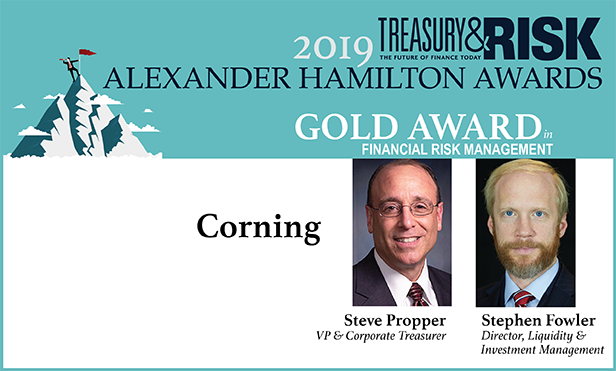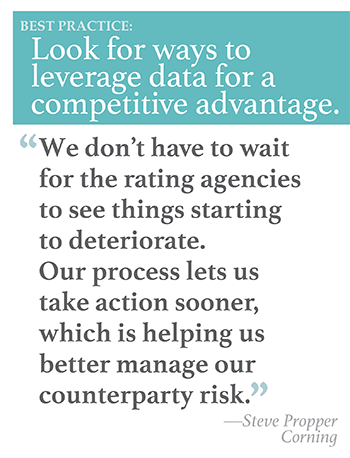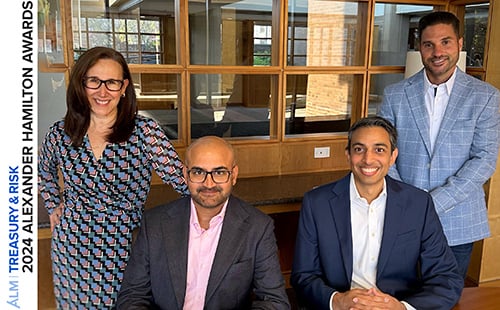
Credit risk management is a big deal at Corning Incorporated. With an accounts receivable portfolio in excess of $1.7 billion and a derivatives portfolio valued at more than $15 billion, the company faces significant exposures to both customers and counterparties. To ensure that it understood those risks, the Corning treasury team was performing thorough credit reviews of all the company's sizable trading partners. These reviews were effective at identifying vulnerabilities, but they weren't efficient.
"It was a very manual process, with individual credit analysts spending a lot of time on each company," explains Stephen Fowler, director of liquidity and investment management for Corning. "A private company with a very small market capitalization would receive the same level of attention as a mega-cap company that was already being covered by credit analysts from S&P, Moody's, and fixed-income houses around Wall Street. We were looking at the same metrics they were, we were just doing it in-house."
Treasury began to re-evaluate the efficiency and effectiveness of its credit risk management. "Our treasury function is driven by the constant quest to make sure we're efficiently utilizing our scarce resources," Fowler says. "We looked at whether it made sense for us to spend time reviewing credits that were already largely being covered by other sources. The answer was that internal staff would be better off focusing on smaller, private companies that are under-followed by the ratings agencies."
At the same time, treasury leaders looked at whether credit risk management processes should move into a shared-service center. This followed a broader trend at the company. Over the past few years, Corning has gradually transitioned a number of routine, repeatable treasury processes into corporate shared-service centers.
"Across the board, we're moving in the direction of having treasury focus more on the policy and less on the execution," explains Steve Propper, vice president and corporate treasurer. As an example, he says, "treasury sets the strategy for our cash management processes and picks our banking partners, but shared services handles all the tasks involved in the execution of the movement of cash. A lot of treasury processes have followed this pattern, and it has been working quite well."
For credit management, the company created a center of excellence in its shared-service center in Budapest. "We moved most of our credit analysts out of treasury," Propper says. "Shared services is now responsible for the execution of credit management, while treasury focuses on setting the overall strategy, monitoring the metrics, and making credit decisions when there's a question." Today, the center of excellence performs a comprehensive credit review of every counterparty for which financial details are not publicly available. Treasury reviews that research, then authorizes the credit limit.
 For customers that are large public companies, treasury developed a streamlined process to estimate probability of default. Due to prior work in the capital markets, Propper and Fowler were familiar with the Merton Distance to Default Model, which looks at the likelihood of default by a given counterparty as a barrier call option on the organization's total assets with a strike price equal to the organization's liabilities. Under their guidance, the treasury team developed a system that pulls data from public feeds, such as Bloomberg, then runs Merton model analytics in Python.
For customers that are large public companies, treasury developed a streamlined process to estimate probability of default. Due to prior work in the capital markets, Propper and Fowler were familiar with the Merton Distance to Default Model, which looks at the likelihood of default by a given counterparty as a barrier call option on the organization's total assets with a strike price equal to the organization's liabilities. Under their guidance, the treasury team developed a system that pulls data from public feeds, such as Bloomberg, then runs Merton model analytics in Python.
"It's very elegant," Fowler says. "We're relying on public market data, so our model updates in real time. And then we're reverse-engineering the math, looking at the probability that the company's liabilities will exceed its equity at any point in the next year."
Despite the model's sophistication, the system doesn't run on autopilot. It calculates the maximum acceptable exposure to each customer. Then Corning's treasury team sets a credit limit at a level below the model's determined maximum. "If a customer's desired credit exceeds that initial limit, or if something changes with their business, we can kick the credit limit out for formal review," Fowler says. "The idea is that we know our risk tolerance, and if our exposure to a particular company gets close to that level, we evaluate whether we should be concerned or we're comfortable with the situation."
For derivatives counterparties, Corning's treasury group wanted to use a modified version of the same process, but one that would factor in the term structure of the company's exposures. They implemented a process that uses a Monte Carlo option model to determine the 95th percentile forward curve for each currency pair in the company's portfolio, for every quarter-end over the life of the contract, and values each derivative at each quarter-end at the modeled forward rate to assess the maximum likely exposure to the bank counterparty.
The process is quite technical, Fowler admits. "We have to value the derivatives over time, even if they're very long-dated, and we have to look at how each currency pair might change over time. We don't just look at our exposure today; we value our maximum foreseeable gain at every quarter-end over the life of the derivative." For each future period, they add up the potential future values of all contracts for the counterparty to arrive at a term structure of the company's counterparty risk.
See also:
- The Opportunity Cost of Risk Avoidance
- On-demand webcast featuring Corning's Stephen Fowler: How Corporate Cash Management Is Evolving
The team reaped the benefits of this approach recently, when one of Corning's financial counterparties experienced business challenges. "The model gave us a yellow warning light very early on," Propper says. "Initially we just moved to shorter-dated derivatives. Then as the yellow light got brighter and brighter, we put even the short-dated derivatives on pause. Since then, conditions for the financial institution have continued to get worse."
This ability to recognize emerging exposures very early is a key benefit of the new process. "We don't have to wait for the rating agencies to see things starting to deteriorate," Propper says. "Once they downgrade a credit, that company's problems are very well-known, and it might already be experiencing a mass exit. Our new process lets us take action sooner, which is helping us better manage our counterparty risk."
In addition, because credit analyses for public counterparties now rely heavily on the new system, the credit analysts in the center of excellence have significantly more time to dedicate to understanding credit risks of the 40 percent of Corning customers that are either private or have requested credit limits above the model's determination of maximum acceptable risk. "Corning's finance function has a vision of being a world-class organization," Propper concludes, "and one of the key deliverables of this framework is the ability to deliver meaningful analysis. The new process yields valuable, actionable insights on meaningful financial exposures for the company."
© Touchpoint Markets, All Rights Reserved. Request academic re-use from www.copyright.com. All other uses, submit a request to [email protected]. For more inforrmation visit Asset & Logo Licensing.



